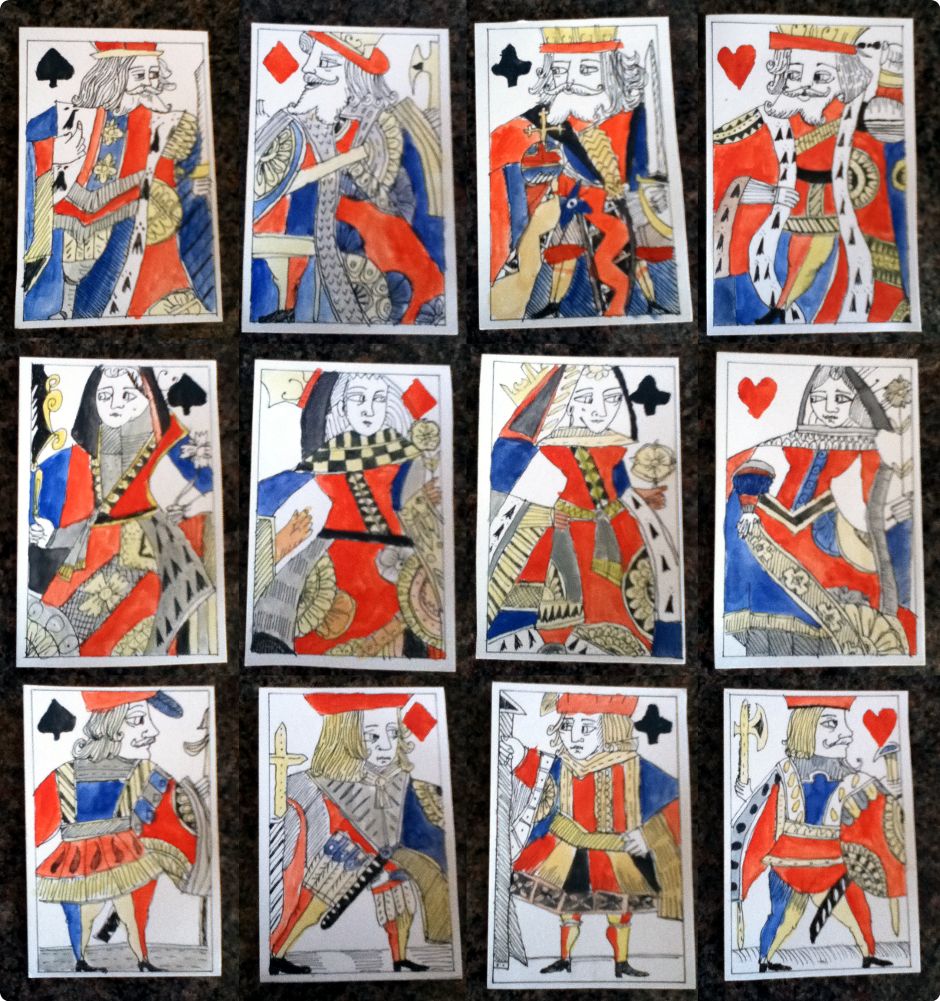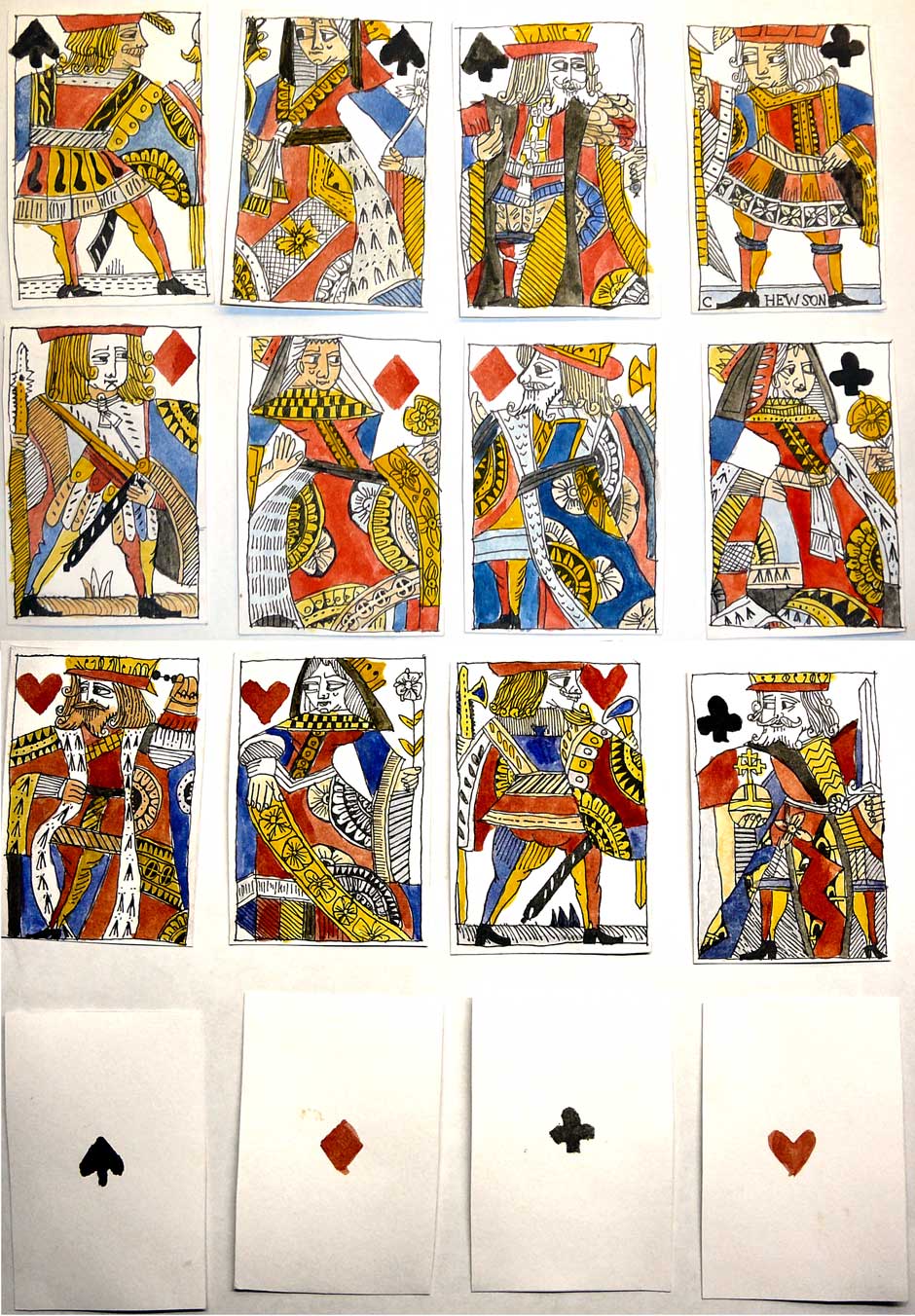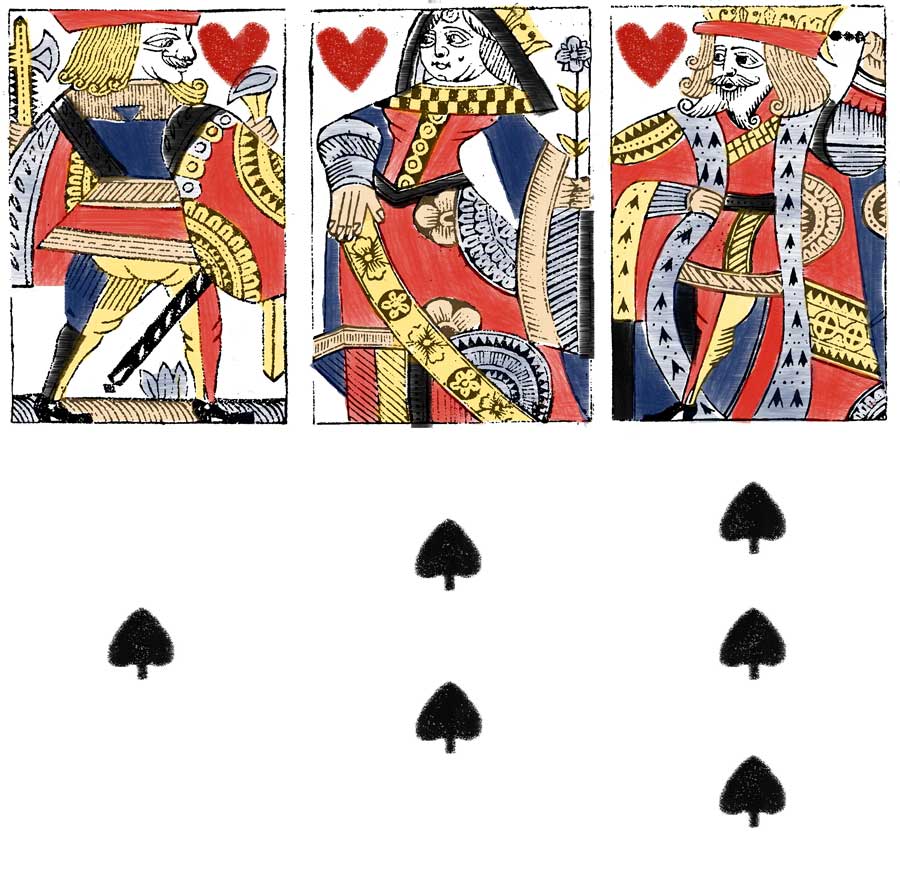David James Binns
Hand-made “Tudor Playing Cards” by David James Binns, age 12.
David James Binns ~ “Tudor Playing Cards”
Hand-made “Tudor Playing Cards” by David James Binns, age 12. David wrote: “I know the clubs aren't perfect, but I'm only twelve so I can't do them as good as real Tudor cards. I set out to make a Hewson/ Tudor replica deck after seeing Tudor artwork and Tudor playing cards. I decided to do it in the correct fashion so made pip templates out of parchment. I made the cards a size between bridge and poker size. As you can see the court cards are not a 100% Hewson design, they are merged with my own ideas as well, I gathered resources from WoPC.co.uk and a sheet of court cards from a museum. (I found the picture on a site about Tudor cards.) It is my first try and the pip stencils wore out at the end, but I am pleased about the outcome.” We think they are excellent and successfully capture the look and feel of real Tudor playing cards.

Above: hand-drawn and painted “Tudor Playing Cards” made by David James Binns, age 12. Images (c) David James Binns 2012.
Version 2 ~ “Hewson Facsimile Playing Cards”
“I sought to make a more historically accurate pack of Hewson facsimile cards that would be more similar to existing replicas available today. I used laminated paper for the stencils, to recreate the “heavily oiled card” used in the 1600s. The card stock was made from white paper pasted on brown thicker paper, records state this is how cards were made in the past. I then pressed them together between wooden boards by hand. I traced the court designs directly from a print of an original Hewson sheet, to give them the most practical historical accuracy. For the paints I used watercolours to recreate the “water based paints”, I spent a while mixing the colours to get the closest colour to the real 17th century paints. I used stencils for the pip cards and hand painted the courts.”

Above: hand-drawn and painted “Hewson Facsimile Playing Cards” made by David James Binns. “I pasted white paper on both sides of cartridge paper to recreate 17th century playing card stock, I then traced the court from a scan of an actual Hewson sheet dated 1680, and painted with water based paints mixed to the closest colours based on actual Hewson cards.” Images (c) David James Binns 2013.
Version 3 ~ “Hewson Facsimile Playing Cards”

Above: these are my latest designs (August 2014). I've been experimenting with different soap polishes, and different papers. I'll make the cards out of three papers, the middle one a dark brown, I think, and polish them. This would, however, be the last digital or hand drawn pack of Hewson cards I should make I think, but that's not to say I won't still design other historical packs. A while ago, I bought some woodcut tools and have been practising on MDF, perhaps one day I could make a woodcut pack of some sort, but that would be a while away.

By Simon Wintle
Member since February 01, 1996
I am the founder of The World of Playing Cards (est. 1996), a website dedicated to the history, artistry and cultural significance of playing cards and tarot. Over the years I have researched various areas of the subject, acquired and traded collections and contributed as a committee member of the IPCS and graphics editor of The Playing-Card journal. Having lived in Chile, England, Wales, and now Spain, these experiences have shaped my work and passion for playing cards. Amongst my achievements is producing a limited-edition replica of a 17th-century English pack using woodblocks and stencils—a labour of love. Today, the World of Playing Cards is a global collaborative project, with my son Adam serving as the technical driving force behind its development. His innovative efforts have helped shape the site into the thriving hub it is today. You are warmly invited to become a contributor and share your enthusiasm.
Related Articles

Boddingtons Bitter playing cards
Cool-looking courts advertising Boddingtons Bitter, originally brewed in Manchester.

OXO Faces of the Millennium Dinner
Twentieth-century personalities promoting a millennium dinner at the Oxo Tower in London.

Kids Fun Box playing cards
Colourful cards for children with four non-standard suits connected with the natural world.

Tangle Foot Ale
Badger Brewery Tangle Foot strong ale advertising pack.

Scientific Whist
“Scientific Whist” : standard cards with instructions for play on the faces by Chas Goodall & Son, 1...

Agent Provocateur
Branded lingerie collection in a pack of pin-up playing cards.

Nimbus playing cards
Mike Steer’s weather-themed pack with suits in four colours and backs for cardistry.

Agatha Christie and Playing Cards revisited
Agatha Christie uses card-play as a primary focus of a story, and as a way of creating plots and mot...

The Decadent Deck
Studies in the eroticism of the female body by Inge Clayton.

Historic Shakespeare
“Historic Shakespeare” playing cards featuring Shakespearean characters by Chas Goodall & Son.

Copechat Paramount Sorting System
Preserving the past: a specimen deck showcasing edge-notched cards and their ingenious sorting syste...

Heartsette by Herbert Fitch & Co, 1893
A glimpse into a busy print and design office in late Victorian London.

Batman® playing cards
Batman playing cards published by InterCol of London 1989.

Can You Believe Your Eyes?
“Can You Believe Your Eyes?” playing cards featuring visual illusions & other oddities.

Pastime Playing Cards for the Blind
The “Pastime” Playing Cards for the Blind manufactured by Goodall & Son Limd., c.1910.

Songs with Flute accompaniment
Eighteenth century English engraved cards with music for voice and flute.
Most Popular
Our top articles from the past 28 days

